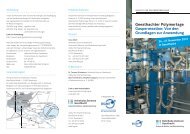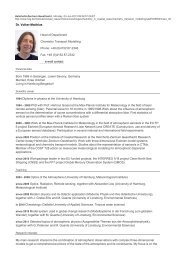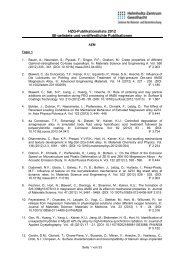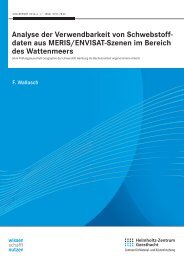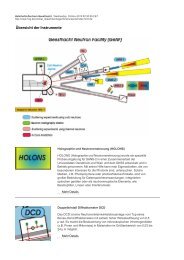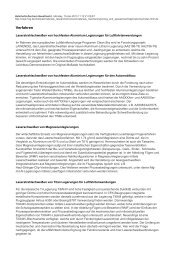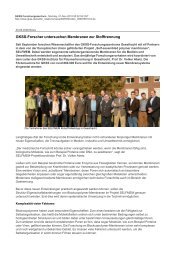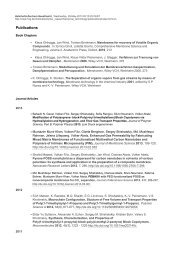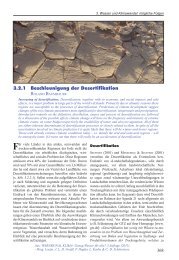Landfills and waste water treatment plants as sources of ... - GKSS
Landfills and waste water treatment plants as sources of ... - GKSS
Landfills and waste water treatment plants as sources of ... - GKSS
Create successful ePaper yourself
Turn your PDF publications into a flip-book with our unique Google optimized e-Paper software.
INTRODUCTION<br />
1.5 Sources<br />
Sources <strong>of</strong> PFCs, PBDEs <strong>and</strong> musk fragrances can be divided into direct <strong>and</strong> indirect <strong>sources</strong>.<br />
Direct <strong>sources</strong> are production <strong>plants</strong> that emit these substances either in the atmosphere or <strong>as</strong><br />
<strong>w<strong>as</strong>te</strong> <strong>water</strong> into rivers (Dingl<strong>as</strong>an-Panlilio <strong>and</strong> Mabury 2006; Prevedouros et al. 2006; Chen<br />
et al. 2007b). Indirect <strong>sources</strong> are the rele<strong>as</strong>e <strong>of</strong> those contaminants from products by<br />
volatilisation <strong>and</strong> during use, application <strong>and</strong> cleaning into <strong>w<strong>as</strong>te</strong> <strong>water</strong> (Simonich et al. 2000;<br />
Hale et al. 2002; Heberer 2002; Palm et al. 2002; Agrell et al. 2004; Prevedouros et al. 2004;<br />
Dingl<strong>as</strong>an-Panlilio <strong>and</strong> Mabury 2006; Kim et al. 2006b; Sinclair et al. 2007; Chen et al. 2009;<br />
Choi et al. 2009; Paul et al. 2009).<br />
Direct emissions <strong>of</strong> ionic PFCs have been identified <strong>as</strong> the major source to surface <strong>water</strong><br />
(Prevedouros et al. 2006; Paul et al. 2009). Ionic PFCs in the atmosphere are predominantly<br />
particle-bound <strong>and</strong> thus subject to rapid deposition (Barton et al. 2006). In contr<strong>as</strong>t, semivolatile<br />
<strong>and</strong> volatile PFCs are emitted directly from production processes <strong>of</strong> fluorosurfactants<br />
(Dingl<strong>as</strong>an-Panlilio <strong>and</strong> Mabury 2006; Prevedouros et al. 2006). However, indirect emissions<br />
by volatilisation <strong>and</strong> application from consumer products that have been reported to contain<br />
semi-volatile <strong>and</strong> volatile PFCs (Dingl<strong>as</strong>an-Panlilio <strong>and</strong> Mabury 2006; Sinclair et al. 2007;<br />
Fiedler et al. 2008; Jensen et al. 2008; Langer 2010) are regarded <strong>as</strong> the dominating source.<br />
Paul et al. (2009) estimated that 85 % <strong>of</strong> total neutral PFC emissions are likely due to these<br />
rele<strong>as</strong>es.<br />
So far, the direct emission <strong>sources</strong> for PBDEs into <strong>water</strong> <strong>and</strong> air are not well known. Since<br />
PBDEs are simply blended to polymers, pl<strong>as</strong>tics <strong>and</strong> electronic housings indirect emissions<br />
are regarded <strong>as</strong> the major <strong>sources</strong> for PBDEs into the atmosphere (Palm et al. 2002;<br />
Prevedouros et al. 2004). This is supported by studies that have been performed on the<br />
leaching characteristics <strong>of</strong> PBDEs from fabrics, such <strong>as</strong> pl<strong>as</strong>tics, TV housings, <strong>and</strong><br />
polyurethane foams (Hale et al. 2002; Kim et al. 2006b; Choi et al. 2009) In 2000, indirect<br />
emissions in Europe were estimated to be 750 kg for BDE47 where<strong>as</strong> BDE99 accounts only<br />
for about 1 kg (Prevedouros et al. 2004). In two coherent studies from southern Sweden <strong>w<strong>as</strong>te</strong><br />
incineration facilities were identified <strong>as</strong> point <strong>sources</strong> for PBDEs to ambient air (Agrell et al.<br />
2004; Ter Schure et al. 2004). In contr<strong>as</strong>t, Prevedouros et al. (2004) estimated BDE47<br />
emissions by this route into the UK atmosphere to be less than 1 kg a -1 <strong>and</strong> concluded that<br />
<strong>w<strong>as</strong>te</strong> incineration is a negligible PBDE source. Recently, Chen et al. (2009) <strong>and</strong> Cahill et al.<br />
(2007) reported elevated air concentrations at electronic <strong>w<strong>as</strong>te</strong> dismantling <strong>and</strong> recycling<br />
22



